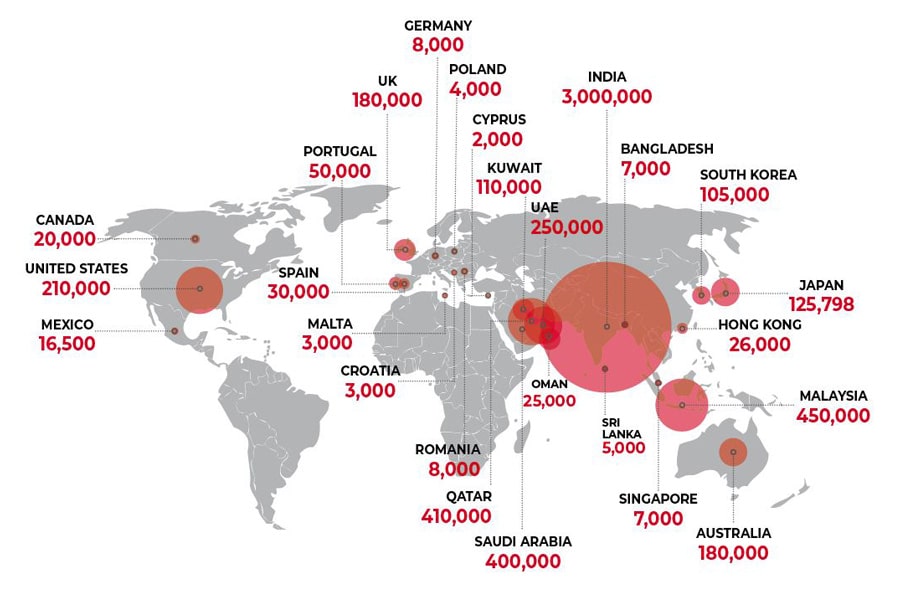Government of Nepal increases taxes for Nepali students studying abroad
- The Nepali government has increased the tax Nepali students must pay on the bank transfers they send to foreign colleges and universities for tuition
- The government seems to be attempting to slow the trend of Nepali students opting for study abroad
- Nepal is an increasingly important sending market for several major study abroad destinations
Nepali families who have saved and borrowed to send their children abroad for education are frustrated at their government’s decision to levy a 3% tax on the payments they send to foreign colleges and universities. This tax rate was announced in May as part of a new national budget and it is already in effect.
Paying tax on payments to foreign educators is nothing new for Nepali families; taxes have been collected in this way for at least a decade. However, the tax rate has moved upwards from 1% to 2% in recent years and now to 3%. This means that a family that would previously have paid USD$600 tax on tuition fees of US$30,000, for example, are now looking at a tax closer to US$1,000 – not a small increase.
Many say that the new tax rate is just one more way the government is attempting to stanch the flow of Nepali students to other countries. For example, students need a No Objection Certificate to study abroad, and at one point this year a policy was announced that barred the granting of those certificates for diploma and language courses abroad. The policy was dropped after about a month following outcry from many groups including agents, receiving institutions, and students.
A pressing issue for the government is the amount of money that exits the country when students choose to study abroad. For example, University World News reports:
“According to records at the Nepal Rastra Bank, students sent US$571 million (NPR75 billion) to different countries to pay their fees in the last 11 months of the fiscal year 2022-23. As much as US$515 million (NPR68 billion) flowed out of the country in the 2021-22 financial year.”
More than 125,000 Nepali students went abroad in 2022, with most opting to study in Australia, Japan, India, and the United States.
Some believe the focus should not be on dissuading students from leaving Nepal, but rather on enticing them to come back. Rajendra Baral, chairperson of the Educational Consultancy Association of Nepal, told University World News that:
“Those travelling abroad not only get an international standard education but also get huge exposure [internationally]. The focus of the government should be on creating an environment to bring them back home after they complete their studies rather than trying to obstruct them from flying.”
The number of Nepalis working, studying, and living abroad is significant, as shown in the following map from the Nepali Times.

An education system under pressure
Many families in Nepal consider study abroad a necessary expense (and financial sacrifice) because their domestic education system is underfunded and suffers due to a lack of qualified teachers.
Cost-cutting measures in the pandemic disproportionately affected teachers, who saw their salaries reduced to the point some were struggling with day-to-day expenses. And in April 2023, some retired teachers did not receive their pension payments while retired military professionals were paid, providing a stark indication of the government’s priorities.
The worrisome state of the education system was highlighted when more than half of Nepali students who sat for their June 2022 Grade 12 examinations failed to pass with the scores required to study at the bachelor’s level.
Will the tax rate increase slow Nepali outbound?
There is natural worry among foreign educators with a strong brand presence in Nepal that the 3% tax will make study abroad too expensive for Nepali families, especially at a time when inflation has dampened consumer spending in the country. Nepal is a top market for Australia and Japan especially, and it has become more important for Canada and the US as well.
An article in the Nepali Times provides a clear illustration of how much some educators now rely on Nepali students:
“At a recent graduation ceremony of one Australian university, 300 students paraded across the stage to receive their diplomas. All were Nepalis, except one. The only white people there were faculty members. A back-of-the-envelope calculation shows that at an average cost of US$30,000 per year for their undergraduate education Nepali students spent US$15 million in just that one university in Australia...The Sydney Morning Herald reported recently that the ‘Nepal market’ was worth AUS$2.6 billion to Australia in 2018/19, up from AUS$1.6 billion the previous year. Nepal is the third biggest source of international students in Australia accounting for 7% of them.”
The millions of dollars Nepali students are spending abroad contrasts with other trends in Nepal’s economy, notes the Nepali Times:
“A conservative estimate shows that Nepalis spent a whopping $3.3 billion for education overseas in just the first six months of this year. By comparison, Nepal’s annual petroleum import bill has risen to $2.5 billion, and tourism brought in less than $1 million in 2019.”
The contrasting trends underline the challenge Nepal’s government finds itself facing regarding outbound student flows from the country. With youth unemployment a persistent issue, attracting Nepali students back to the country after their foreign studies are completed is not the easiest of tasks.
Those who do want to return are often frustrated by bureaucratic processes. Speaking with the Himalayan Times this month, Aastha Dahal, who holds a PhD from the University of Cambridge, said she has had to struggle for an equivalence certificate from Tribhuvan University, Nepal’s oldest and largest university. She said, “There are plenty of students suffering due to this and many have already left the country.”
Dirgha Raj Joshi, a Nepali student in the US, told the Times:
“I can apply anywhere in the world before completion of my PhD, but there are no vacancies in my country. Even for the post of professor, I have to take a written exam, and it takes years to get the results. I will go through all this process, but before this, I have to get my degree equivalence certificate as I studied abroad. When the country's youth do not see future in their own country, the future of that country will never be bright.”
For additional background, please see:
















